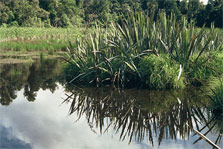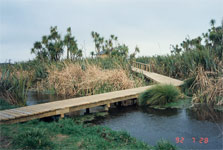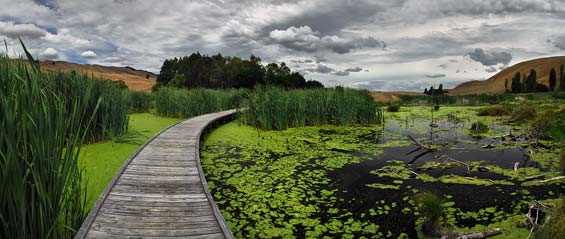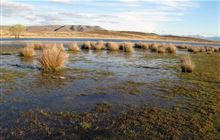Why wetlands are important
Introduction
Wetlands have many surprising benefits including improving water quality and reducing floods.Environmental benefits
Water quality
Wetlands improve water quality. As water moves into a wetland, the flow rate decreases, allowing particles to settle out. The many plant surfaces act as filters, absorbing solids and adding oxygen to the water. Growing plants remove nutrients and play a cleansing role that protects the downstream environments.
Flood control
Wetlands can also reduce the impacts of flooding, as they can absorb heavy rain and release water gradually. Downstream water flows and ground water levels are also maintained during periods of low rainfall. Wetlands help stabilise shorelines and riverbanks.
Wildlife habitat
Many wetland plants have specific environmental needs and are extremely vulnerable to change. Some of our endangered plant species depend totally on wetlands.
Wetlands support great concentrations of bird life and far more species than a similar forest area. The survival of threatened species such as the Australasian bittern//matuku-hūrepo, brown teal, fernbird, marsh crake and white heron relies on remnant wetlands.
Native fish need wetlands too. Eight of New Zealand's 27 species including inanga, short-finned eels, kōkopu and bullies are found in wetlands, while the whitebait fishery depends on the spawning habitat offered by freshwater wetlands. The decline in native fish populations is directly related to massive reductions in freshwater habitat.

Wetland, Lake Arthur Scenic Reserve, West Coast

Boardwalk, Pukepuke Lagoon

Pekapeka wetland in Hawke's Bay is wonderful restored with a number of walking trails
Historical importance
Wetlands were a treasure trove for early Māori, providing flax for clothing, mats, kits and ropes, raupō for thatching and dried moss for bedding.
The eels, fish and birds which lived there were a good food source and the feathers of birds like pūkeko and bittern were used to adorn cloaks and other garments. Waterways were an important means of access by waka (canoe).
International and economic significance
The international significance of wetlands is reflected in the Convention on Wetlands (the Ramsar Convention).
The Ramsar Convention launched an international report in 2013, The Economics of Ecosystem and Biodiversity for Water and Wetlands.
The report states the need for a major shift in our attitudes towards wetlands. We need to recognise their value in delivering water, raw materials and food. They are essential both for life and the sustainability of the world's economies.
Recreation and education
Wetlands offer many recreation opportunities including boating, fishing, swimming, bird watching, whitebaiting and hunting.
Wetlands support a wide diversity of species, in large numbers. Their popularity is proven by ample visitor numbers at places like Sinclair Wetland near Dunedin, and the Miranda Shorebird Centre at the Firth of Thames. Arawai Kakariki sites (Awarua, Ōtūwharekai and Whangamarino) also attract lots of visitors.
There are also many interesting education opportunities, and we have produced a number of education kits and resources on wetlands.

